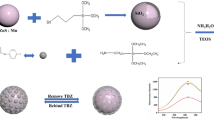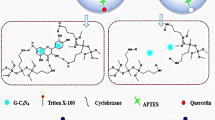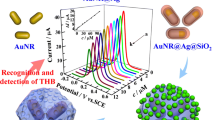Abstract
Herein, rare-earth europium doped in Gd2O3@SiO2-based molecularly imprinted polymer (MIP) composite nanospheres with a multilayer core-shell structure was successfully prepared via a facile and versatile layer-by-layer assembly strategy of combination with sol-gel, hydrothermal, and surface imprinting procedure. The rare-earth Gd2O3:Eu3+ was embedded into the inner portion of the imprinted polymer which was well-suited for fluorescent monitoring carbaryl selectively. Results showed that the recognition process of the nanosensor for carbaryl was fast and reached dynamic equilibrium at ca. 20 min. The fluorescence intensity (F0/F) is linearly related to the concentration of carbaryl [Q] within the range of 16–80 μg mL−1, and the linear equation is F0/F = 0.8909 − 9.775 × 10−4[Q] (R = 0.9963) with 10 μg mL−1 as the detection limit. Competition experiments showed that other analogues (methomyl, aldicarb, and isoprocarb) have nearly no interference in the detection of carbaryl. Moreover, this MIP nanosensor was successfully applied to detect carbaryl in green tea samples without pretreatment. The study afforded an efficient and desirable fluorescence sensor for carbaryl detection in a complicated matrix, which hopefully will be used for biomedical/chemical sensing recognition.

Graphical abstract




Similar content being viewed by others
References
Lukowicz C, Ellero-Simatos S, Régnier M, Polizzi A, Lasserre F, Montagner A, et al. Metabolic effects of a chronic dietary exposure to a low-dose pesticide cocktail in mice: sexual dimorphism and role of the constitutive androstane receptor. Environ Health Perspect. 2018;126:067007.
Alvarez-Diaz A, Costa JM, Pereiro R, Sanz-Medel A. Halogenated molecularly imprinted polymers for selective determination of carbaryl by phosphorescence measurements. Anal Bioanal Chem. 2009;394:1569–76.
Goulson D, Nicholls E, Botías C, Rotheray EL. Bee declines driven by combined stress from parasites, pesticides, and lack of flowers. Science. 2015;347:1255957.
Kim N, Park IS, Kim DK. High-sensitivity detection for model organophosphorus and carbamate pesticide with quartz crystal microbalance-precipitation sensor. Biosens Bioelectron. 2007;22:1593–9.
Gou Y, Eisert R, Pawliszyn J. Automated in-tube solid-phase microextraction-high-performance liquid chromatography for carbamate pesticide analysis. J Chromatogr A. 2000;873:137–47.
Takino M, Yamaguchi K, Nakahara T. Determination of carbamate pesticide residues in vegetables and fruits by liquid chromatography-ptmospheric pressure photoionization−mass spectrometry and atmospheric pressure chemical ionization-mass spectrometry. J Agric Food Chem. 2004;52:727–35.
Ferrer I, Thurman EM, Fernández-Alba AR. Quantitation and accurate mass analysis of pesticides in vegetables by LC/TOF-MS. Anal Chem. 2005;77:2818–25.
Long Z, Xu W, Peng Y, Lu Y, Luo Q, Qiu H. Highly selective coextraction of rhodamine B and dibenzyl phthalate based on high-density dual-template imprinted shells on silica microparticles. J Sep Sci. 2017;40:506–13.
Long Z, Xu W, Lu Y, Qiu H. Nanosilica-based molecularly imprinted polymer nanoshell for specific recognition and determination of rhodamine B in red wine and beverages. J Chromatogr B. 2016;1029-1030:230–8.
Gao D, Zhang Z, Wu M, Xie C, Guan G, Wang D. A surface function monomer-directing strategy for highly dense imprinting of TNT at surface of silica nanoparticles. J Am Chem Soc. 2007;129:7859–66.
Spégel P, Schweitz L, Nilsson S. Molecularly imprinted polymers. Anal Bioanal Chem. 2002;372:37–8.
Zhao Y, Ma Y, Li H, Wang L. Composite QD@MIP nanospheres for specific recognition and direct fluorescent quantification of pesticides in aqueous media. Anal Chem. 2012;84:386–95.
Rouhani S, Nahavandifard F. Molecular imprinting-based fluorescent optosensor using polymerizable 1, 8-naphthalimide dye as a florescence functional monomer. Sensors Actuators B Chem. 2014;197:185–92.
Uzun L, Uzek R, Sene S, Say R, Denizli A. Chiral recognition of proteins having L-histidine residues on the surface with lanthanide ion complex incorporated-molecularly imprinted fluorescent nanoparticles. Mater Sci Eng C. 2013;33:3432–9.
Zhang W, Liu W, Li P, Xiao H, Wang H, Tang B. A fluorescence nanosensor for glycoproteins with activity based on the molecularly imprinted spatial structure of the target and boronate affinity. Angew Chem Int Ed. 2014;53:12489–93.
Liu H, Fang G, Wang S. Molecularly imprinted optosensing material based on hydrophobic CdSe quantum dots via a reverse microemulsion for specific recognition of ractopamine. Biosens Bioelectron. 2014;55:127–32.
Zhou Z, Li T, Xu W, Huang W, Wang N, Yang W. Synthesis and characterization of fluorescence molecularly imprinted polymers as sensor for highly sensitive detection of dibutyl phthalate from tap water samples. Sensors Actuators B Chem. 2017;240:1114–22.
Stöber W, Fink A. Controlled growth of monodisperse silica spheres in the micron size range. J Colloid Interface Sci. 1968;26:62–9.
Tseng TK, Choi J, Davidson M, Holloway PH. Synthesis and luminescent characteristics of europium dopants in SiO2/Gd2O3 core-shell scintillating nanoparticles. J Mater Chem. 2010;20:6111–61115.
Lin C, Kong D, Liu X, Wang H, Yu M, Lin J. Monodisperse and core-shell-structured SiO2@YBO3:Eu3+ spherical particles: synthesis and characterization. Inorg Chem. 2007;46:2674–81.
Li CC, Zeng HC. Coordination chemistry and antisolvent strategy to rare-earth solid solution colloidal spheres. J Am Chem Soc. 2012;134:19084–91.
Liu G, Hong G, Sun D. Synthesis and characterization of SiO2/Gd2O3: Eu core-shell luminescent materials. J Colloid Interface Sci. 2004;278:133–8.
Wang H, Yang J, Zhang CM, Lin J. Synthesis and chanracterization of monodisperse spherical SiO2@RE2O3 (RE = rare earth elements) and SiO2@Gd2O3: Ln3+ (Ln = Eu, Tb, Dy, Sm, Er, Ho) particles with core-shell structure. J Solid State Chem. 2009;182:2716–24.
Guo T, Deng Q, Fang G, Gu D, Yang Y, Wang S. Upconversion fluorescence metal-organic frameworks thermosensitive imprinted polymer for enrichment and sensing protein. Biosens Bioelectron. 2016;79:341–6.
Liu Q, Fei A, Huan J, Mao H, Wang K. Effective amperometric biosensor for carbaryl detection based on covalent immobilization acetylcholinesterase on multiwall carbon nanotubes/graphene oxide nanoribbons nanostructure. J Electroanal Chem. 2015;740:8–13.
Song Y, Zhang M, Wang L, Wan L, Xiao X, Ye S, et al. A novel biosensor based on acetylecholinesterase/prussian blue–chitosan modified electrode for detection of carbaryl pesticides. Electrochim Acta. 2011;56:7267–71.
Sánchez-Barragán I, Karim K, Costa-Fernández JM, Piletsky SA, Sanz-Medel A. A molecularly imprinted polymer for carbaryl determination in water. Sensors Actuators B Chem. 2007;123:798–804.
Sun J, Dong T, Zhang Y, Wang S. Development of enzyme linked immunoassay for the simultaneous detection of carbaryl and metolcarb in different agricultural products. Anal Chim Acta. 2010;666:76–82.
Tsogas GZ, Giokas DL, Nikolakopoulos PG, Vlessidis AG, Evmiridis NP. Determination of the pesticide carbaryl and its photodegradation kinetics in natural waters by flow injection–direct chemiluminescence detection. Anal Chim Acta. 2006;573-574:354–9.
Caetano J, Machado SAS. Determination of carbaryl in tomato “in natura” using an amperometric biosensor based on the inhibition of acetylcholinesterase activity. Sensors Actuators B Chem. 2008;129:40–6.
Cesarino I, Moraes FC, Lanza MRV, Machado SAS. Electrochemical detection of carbamate pesticides in fruit and vegetables with a biosensor based on acetylcholinesterase immobilised on a composite of polyaniline-carbon nanotubes. Food Chem. 2012;135:873–9.
Gauthier TD, Shane EC, Guerln WF, Seltz WR, Grant CL. Fluorescence quenching method for determining equilibrium constants for polycyclic aromatic hydrocarbons binding to dissolved humic materials. Environ Sci Technol. 1986;20:1162–6.
Mauriz E, Calle A, Abad A, Montoya A, Hildebrandt A. Determination of carbaryl in natural water samples by a surface plasmon resonance flow-through immunosensor. Biosens Bioelectron. 2006;21:2129–36.
Funding
The authors gratefully acknowledge the financial support of the Xinjiang provincial young talent fund project (Grant No. 2017Q063), Xinjiang Bureau of Quality and Technical Supervision (No. 1502, No. 201602, and No. 201612), and Urumqi City major science project (Grant No. Y141320007).
Author information
Authors and Affiliations
Corresponding authors
Ethics declarations
Conflict of interest
The authors declare that they have no conflict of interest.
Additional information
Published in the topical collection New Insights into Analytical Science in China with guest editors Lihua Zhang, Hua Cui, and Qiankun Zhuang.
Publisher’s note
Springer Nature remains neutral with regard to jurisdictional claims in published maps and institutional affiliations.
Electronic supplementary material
ESM 1
(PDF 174 kb)
Rights and permissions
About this article
Cite this article
Long, Z., Shen, S., Lu, Y. et al. Monodisperse core-shell-structured SiO2@Gd2O3:Eu3+@SiO2@MIP nanospheres for specific identification and fluorescent determination of carbaryl in green tea. Anal Bioanal Chem 411, 4221–4229 (2019). https://doi.org/10.1007/s00216-019-01902-2
Received:
Revised:
Accepted:
Published:
Issue Date:
DOI: https://doi.org/10.1007/s00216-019-01902-2




